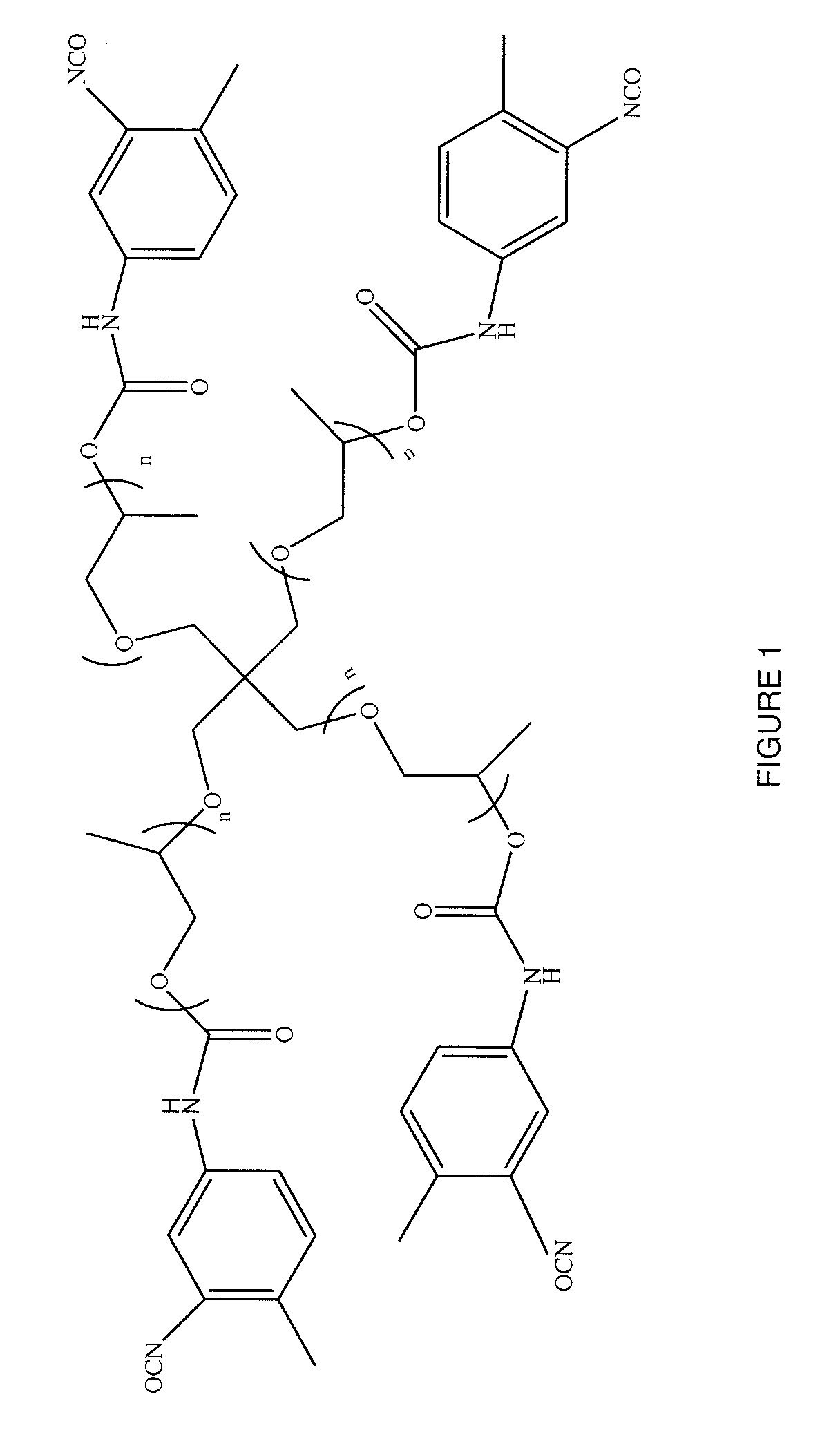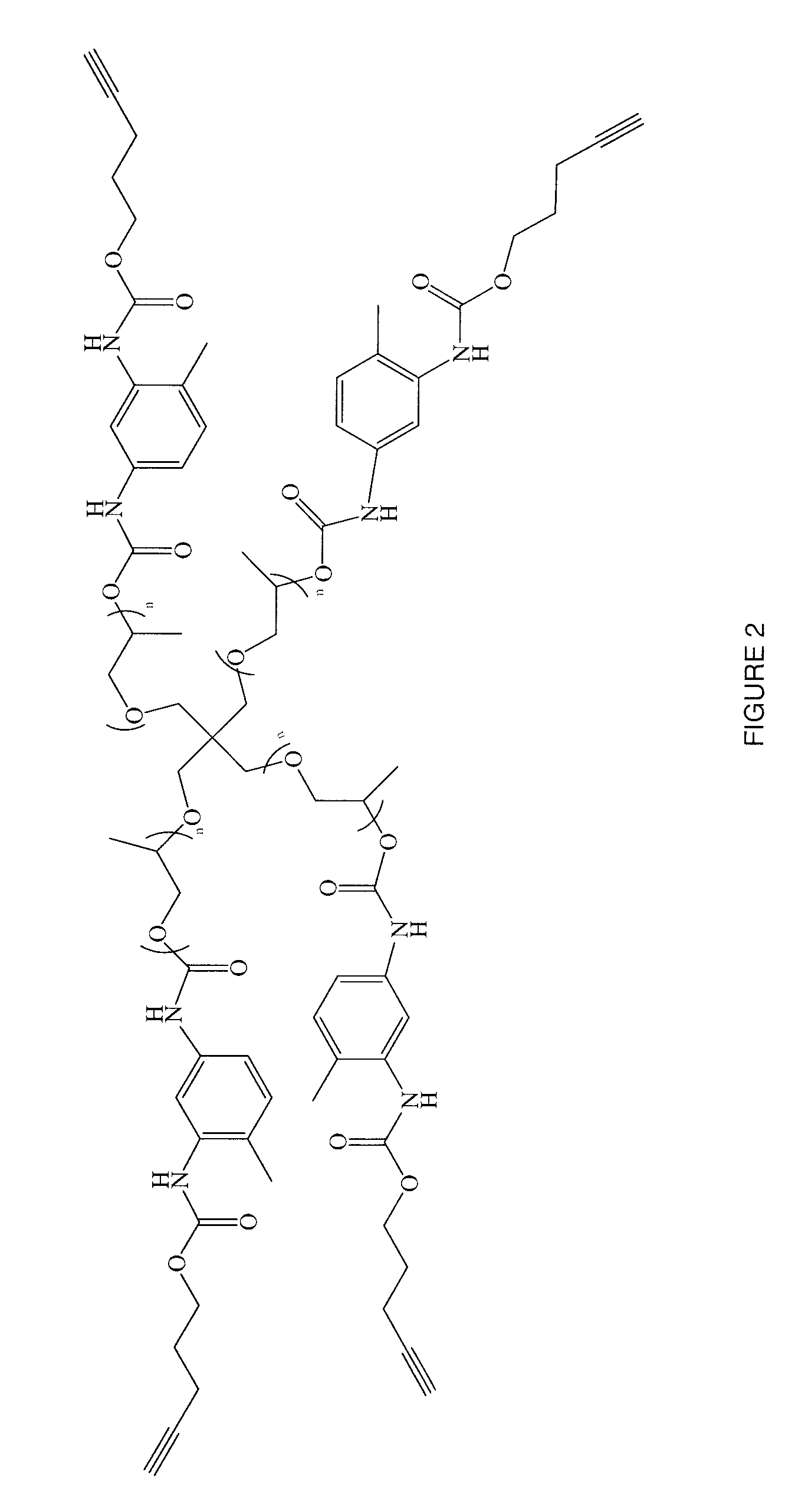Bioadhesive Composition Formed Using Click Chemistry
- Summary
- Abstract
- Description
- Claims
- Application Information
AI Technical Summary
Problems solved by technology
Method used
Image
Examples
example 1
[0082]A tosylate was prepared for use in synthesizing an azide. About 10 mL of tetrahydrofuran (THF) was added to a solution of about 3.6 grams (about 5 mmoles) pentaerythritol ethoxylate and about 1.45 grams sodium hydroxide (about 36 mmoles) in about 10 mL of water. Pentaerythritol ethoxylate (sometimes referred to herein as pentaerythritol-EO) has the following structure:
wherein n is from about 3 to about 60, in embodiments from about 4 to about 8.
[0083]About 4.31 grams (about 23 mmoles) of solid p-toluenesulfonyl chloride (p-Tos-Cl) was then added to the above solution at room temperature (about 21±5° C.) under a nitrogen atmosphere for about 24 hours. The reaction mixture was then diluted with about 30 mL of water and extracted 4 times with 40 mL of ethyl acetate. The organic phase was dried over magnesium sulfate, filtered, evaporated and dried under high vacuum. The resulting product was analyzed by proton NMR in deuterated chloroform. Treatment of the NMR sample with trichlo...
example 2
[0085]A 4-arm azide was prepared for a click reaction with a polyacetylene. About 2.76 grams (about 2 mmoles) of the pentaerythritol-Tos polysulfonate prepared in Example 1 above was reacted with about 0.57 grams (about 9 mmoles) of sodium azide (NaN3) in about 10 mL of dimethyl formamide. The reaction mixture was stirred at about 60PC under a nitrogen atmosphere. The reaction mixture was partitioned between about 15 mL of water and about 40 ml of ether. The two phases were separated and the aqueous phase was extracted with about 25 mL of ether. The combined organic phase was dried over magnesium sulfate, filtered and evaporated. The residue was analyzed by NMR. The NMR spectrum confirmed the displacement of the tosylate groups.
[0086]The 4-arm azide thus produced was as follows:
where n is a number from about 3 to about 60, in embodiments from about 4 to about 8.
example 3
[0087]An acetylenic derivative was prepared for use in a click reaction. About 15.75 grams (about 25 mmoles) of pentaerythritol propoxylate was slowly added to about 21.81 grams (about 125 mmoles) of 2,4-tolylene diisocyanate (TDI) at room temperature (about 21±5° C.). The mixture was then heated at about 65° C. for about 18 hours. The reaction mixture was washed seven times with petroleum ether. For each of the washings, about 45 mL of petroleum ether was added and the reaction mixture was stirred at about 65° C. for a period of time of from about 10 minutes to about 15 minutes. The mixture was decanted and the supernatant petroleum ether was removed with a pipette. The process was repeated six times; the resulting material was dried under a vacuum to provide a pentaerythritol propoxylate-TDI adduct. The material had a free isocyanate content of about 13.49%, as determined by titration. The pentaerythritol propoxylate-TDI adduct was of the formula depicted in FIG. 1, where n was fr...
PUM
| Property | Measurement | Unit |
|---|---|---|
| Ratio | aaaaa | aaaaa |
| Bioadhesion | aaaaa | aaaaa |
Abstract
Description
Claims
Application Information
 Login to View More
Login to View More - R&D
- Intellectual Property
- Life Sciences
- Materials
- Tech Scout
- Unparalleled Data Quality
- Higher Quality Content
- 60% Fewer Hallucinations
Browse by: Latest US Patents, China's latest patents, Technical Efficacy Thesaurus, Application Domain, Technology Topic, Popular Technical Reports.
© 2025 PatSnap. All rights reserved.Legal|Privacy policy|Modern Slavery Act Transparency Statement|Sitemap|About US| Contact US: help@patsnap.com



